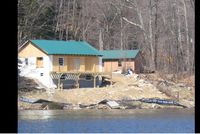October 3 - Shoreline Protection Meeting

Vermont is the only state in New England with no required lakeshore development review or standard. Photo by VT DEC.
The final fall meeting on shoreline protection will be held Thursday October 3 from 6:00 - 8:00 PM at Contois Auditorium in Burlington. Please attend and and speak out in favor of protecting our waterways!
Last winter the Legislature established a Lake Shoreland Protection Commission in anticipation of further legislative action in 2014. The Shoreland Commission and the Vermont Department of Environmental Conservation have been hosting meetings throughout the state to explain Vermont’s water quality programs and outline the need for greater lakeshore protection as one overdue measure in the state’s clean water strategy. The October 3 meeting is the last one this fall. The meeting format allows attendees to write their questions and comments on cards which are then responded to by the Commission. It's critical that lawmakers hear strong support for safeguarding our lakes at the meetings.
Why are greater shoreland protections needed?
Currently, any shoreline zoning is left to local communities but only 20% of towns have taken advantage of such opportunities, leaving many of the state's shorelines vulnerable to clear-cutting and unrestrained development.
Only 17% of Vermont lakeshores are in good condition as measured by the extent of disturbance and lawns along the shore, compared to 42% regionally and 35% nationally.
Steps can be taken to minimize the problems simply by increasing vegetative buffers. Maine instituted such measures 40 years ago.
- Today, 80% of Maine lakes show low stress with the remaining 20% showing moderate stress.
- In Vermont only 12.5% of lakes show low stress with 37.5% showing moderate stress and 50% indicating high stress.
- In Maine there's no difference between developed and undeveloped lots in terms of habitat indicators.
- In Vermont, developed lots show significant depletion in terms of habitat indicators.
- A 100-foot vegetated buffer absorbs 73% of stormwater runoff; a bare grass lawn absorbs only 18%.
- Cleared shorelines contribute 18 times more sediment, five times more runoff and seven times more phosphorus to lakes than those where the shoreline is wooded.
Shoreline development causes problems for fish.
- Bass preferentially build nests along undeveloped shorelines.
- Bass take 1.5 growing seasons longer to reach the legal size for catching in developed lakes.
- Trout get most of their food from terrestrial insects in undeveloped lakes; at most 2% in developed lakes.
- Trout in developed lakes ingest 50% less energy daily than those in undeveloped lakes.
- Development decreases macro-invertebrate diversity in lakes leading to less and fewer types of food for fish.
